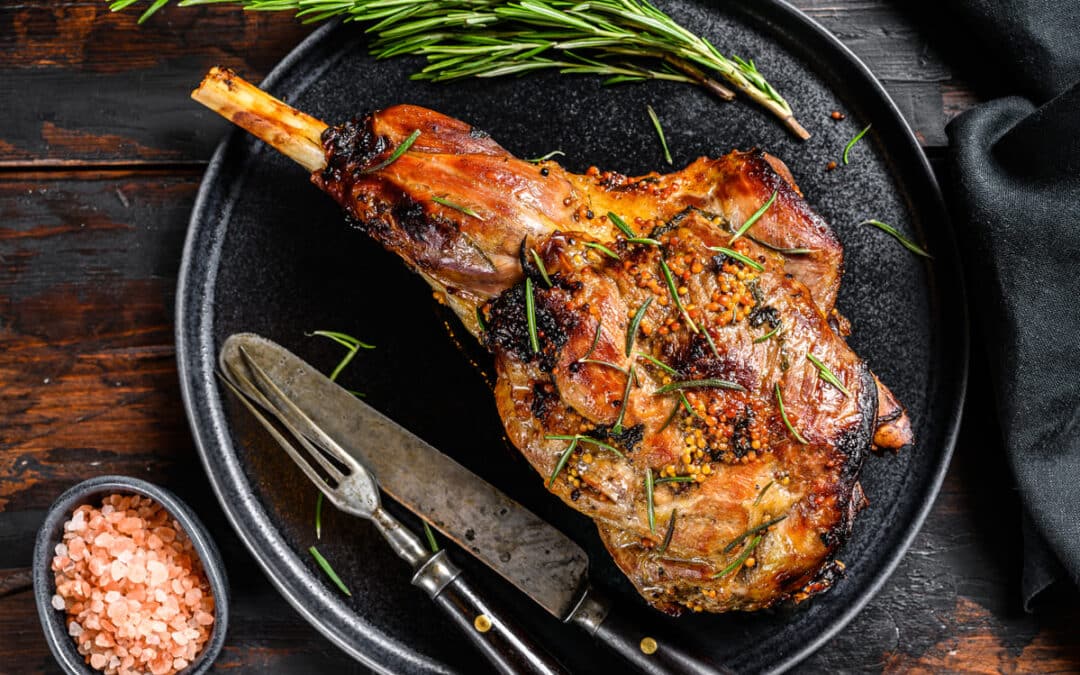The anticipation mounts. The excitement is in the air. The unopened bottle of Hill Family Estate Clarke Vineyard Syrah sits on the countertop, enticing, beckoning, gently singing its song to us. We eagerly look forward to its bold profile, with the smoke and spice notes balancing the fig and black cherry, but we might wonder what is the perfect dish to pair with this “barbecue in a bottle.”
The short answer is: any grilled meat will work well with this wine. The long answer, well, have you considered a Greek yogurt marinated leg of lamb served with braised fennel and fresh fava bean puree? Pour yourself a glass of a delicious Hill Family Estate wine (save the Syrah for dinner, while cooking, might we suggest a lovely pour of Cuvee Charlotte?), put on your apron, and let’s get cooking!
Day One (one or two days before cooking)
Make the marinade:
- 1 cup Greek yogurt
- 3 garlic cloves, minced or run through a garlic press
- Fresh herbs: I like about six sprigs of thyme, three of rosemary, perhaps a pinch of rue, a sprig of sage is nice, but not necessary, fresh oregano and marjoram and mint are fine, but keep them down to one or two sprigs each. I always add a couple of fresh, finely chopped Turkish bay leaves. If you don’t have fresh herbs, stick with a generous pinch each of dried thyme, oregano and rosemary. Chop the herbs as finely as you have patience for. (PRO TIP for fresh herbs: thyme, oregano, marjoram and mint are all members of the mint family, and should be spanked first. It seems silly. It looks silly. You put the herbs in your secondary hand and give them a good slap with your dominant hand. It really does release a lot of aroma that way. Just trust me, and spank the herbs)
- Salt and freshly cracked pepper
- Mix all of the above ingredients together, taste, and adjust.
- Rub the leg of lamb (preferably bone-in, but boneless is not a deal-breaker here) with salt, freshly cracked pepper, and the marinade. Place in a non-reactive container with a lid (or plastic wrap), and marinate overnight in the refrigerator.
Day Two
In the morning, peel your fava beans. Pop the beans into salted, boiling water for three minutes, then transfer to a bowl of ice water. Now, pop the inner bean out, discarding the husk. I know, it is a lot of work, but the rewards make it worth it. Put the par-boiled beans in a small sauce pan with half a cup of water, two sprigs of rosemary, chopped, a clove of garlic, minced, a dash of Extra Virgin Olive Oil, salt and freshly cracked pepper. Cook until the water is just about gone. You can puree the fava beans in a blender or with a fork, which will result in a chunkier texture. This can be broken into steps, with logical breaking points between the peeling, the parboiling/de-husking, and the final cooking.
Quarter your fresh fennel (about a bulb per person, maybe allow more, as this will be a popular side), lay it in a single layer in a skillet, cover to about ⅔ with milk, dot with butter (about ½ Tablespoon per bulb), season with salt and pepper, and cook, covered, over low heat for about 20 minutes. When it is fork tender, remove the lid, raise the heat, and reduce the liquid until it is almost gone, with a few clots of curdled milk remaining (It sounds bad, it looks iffy, but trust me on this one). Transfer everything, including the milk solids, to a buttered oven-proof dish. Grate reggiano parmigiana over the fennel, along with freshly cracked pepper and freshly grated nutmeg. 20 minutes before serving, put it in a 400 degree oven. Note: Once it is done with the initial braising, you can hold it until you are approaching dinner time. Once it is in the oven, bake until lightly browned, and serve.
Build your fire (if you are using a gas grill, skip this step). I use mesquite charcoal with wet oak chips added right before cooking. I use a three zone fire, with the fire on the left (zone 1), and the meat on the right (zone 3), with the middle zone empty as a buffer, so that the lamb will cook at a fairly high temperature, but it is not directly over the fire. Lamb fat will drip and flare, so this is a precaution against fire (and cooking the lamb too quickly). The amount of time it will take to cook the lamb will depend on the size of the leg and the temperature of the fire. I do tend to cook leg of lamb all the way. Rare is great for rack of lamb, but for leg, I find the flavor develops best when it is cooked through, at 145 degrees Fahrenheit (internal temperature – use an instant read thermometer). Allow the lamb to rest, uncovered, for 10 minutes and slice parallel to the bone (I know, you were taught to slice against the grain. Trust me. Slice it parallel to the bone).
Now. With the leg of lamb, fava puree, and braised and gratineed fennel, you are ready to drink that delicious Hill Family Estate Clarke Vineyard Syrah. Bon Appetit!

